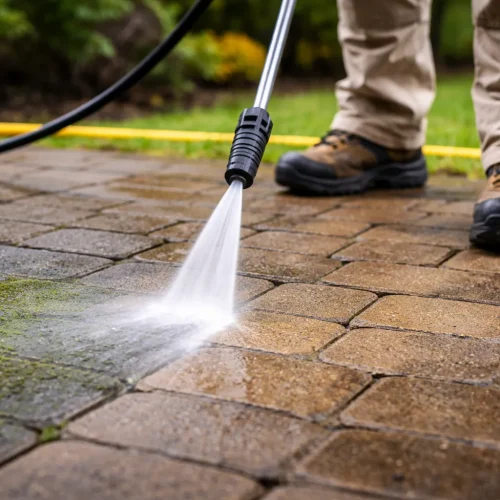
If your compact tractor, mini-excavator, or skid-steer goes down mid-project, the lost time adds up fast. Unplanned downtime is costly when you factor in labor and schedule delays. For property owners or hobby farmers, even a single idle weekend can postpone important work for weeks. The good news is that most breakdowns are simple fixes, provided you can locate reliable replacement parts without overpaying or risking counterfeits. In this guide, you will learn how to:
- Identify the exact part numbers your machine requires
- Decide when OEM or aftermarket parts make the most sense
- Vet suppliers, both online and offline, so you receive quality components every time
- Save money through smart buying and solid maintenance habits
Master these steps to dramatically cut downtime, protect your equipment investment, and keep your property-improvement plans on track.
Know Your Machine & Part Numbers
Before you start hunting for deals, you must collect the specific information that guarantees compatibility. This step prevents costly returns and frustrating delays. Every machine has a unique identity encoded on its data plates.
Find the Model and Serial Plates
These metal tags contain your machine’s critical identification information. Their location varies by manufacturer and equipment type, but common spots include:
- Tractors: Look on the main frame, often near the engine block, under the hood, or on the dashboard support structure.
- Mini-excavators: Check inside the operator cab door jamb, on the exterior of the swing frame, or on the chassis below the cab.
- Skid-steers: Typically found on the left side of the chassis, sometimes hidden beneath the main lift arm when it’s in the lowered position.
Photograph these plates for your records. The serial number is especially critical, as manufacturers often make running changes to parts mid-production cycle.
Use OEM Manuals and Online Diagrams
Most major brands host free, searchable parts catalogs on their official websites, which contain invaluable exploded-view diagrams. Navigate to the specific system (e.g., hydraulics, undercarriage) and pinpoint the exact component. Always use your machine’s serial number to filter the results and screenshot the relevant diagrams for your records.
Create a Digital “Equipment Passport”
A simple spreadsheet can save you hours of frantic searching when a machine is down. Create a file with columns for the machine’s make, model, serial number, and a list of common wear-part numbers like filters and belts. Store this file in a cloud service and keep the photos of the serial plates in the same folder for quick reference.
OEM vs. Aftermarket Parts: What’s Best for You?
The debate between OEM and aftermarket parts is ongoing, but the right choice often depends on the specific component, the age of your machine, and your budget.
Definition Refresher
OEM (Original Equipment Manufacturer) parts are produced by the brand that built your machine or by their licensed suppliers. They come in a branded box and are identical to what a dealer would use for a repair. Aftermarket parts are made by third-party companies. These parts are designed to fit and function like the OEM originals and may even be engineered with improvements to address known weaknesses in the original design.
Pros & Cons at a Glance
When weighing your options, consider these factors:
- Price: OEM parts carry the highest price tag, while aftermarket parts are typically cheaper, offering significant savings.
- Availability: The aftermarket offers a much wider sourcing network, though dealers usually have a good stock of common parts.
- Warranty Impact: In the U.S., the Magnuson-Moss Warranty Act protects you: a manufacturer cannot void your warranty solely for using aftermarket parts unless they prove the part caused the failure.
- Performance: OEM parts offer a guaranteed fit, while aftermarket quality can vary from excellent to poor, making supplier research essential.
When OEM is Mandatory
For certain critical systems, sticking with OEM is non-negotiable. This includes sensitive electronics like engine control modules (ECMs), complex emission-regulated components, and any part that fails while the machine is still under its original factory warranty.
Smart Aftermarket Buys
High-quality aftermarket options provide excellent value for many components. These are ideal for high-wear items like bucket teeth, cutting edges, and track shoes. Filters and seals from reputable brands often meet or exceed OEM specifications at a fraction of the cost.
Where to Source Parts You Can Trust
Once you know what you need, the next step is finding a reliable supplier. Your options range from local dealerships to a vast world of online sellers.
Authorized Dealers
Your local dealer is the most straightforward source for OEM parts. They offer guaranteed compatibility, handle warranties directly, and provide valuable technical support from factory-trained technicians. You can verify a dealer’s legitimacy using the locator tool on the OEM’s official website.
Reputable Online Marketplaces
E-commerce has expanded choices, but it requires careful due diligence. Stick to sellers with professional websites, clear return policies, and live customer support. A trustworthy seller will also provide multiple high-resolution photos of the part. When searching for specific components, such as heavy-duty excavator parts, always compare pricing, shipping speed, and recent buyer reviews before finalizing a purchase.
Salvage Yards & Remanufactured Options
For older machines or major components, salvage yards can be a goldmine, and a quality remanufactured part can cost less than a new one. Before buying, confirm the supplier’s remanufacturing procedure involves a complete teardown, inspection, and replacement of all wear components. Always ask for a warranty in writing.
Red Flags to Avoid
Protect yourself from scams by watching for warning signs. Watch for counterfeit packaging with misspelled brand names, prices that seem too good to be true, and parts with missing or ground-off serial numbers. Vague shipping timelines can also indicate a seller who does not have the part in stock.
Quality Verification & Supplier Checks
Before committing to a large purchase from a new supplier, take a few extra steps to verify their legitimacy and the quality of their products.
- Ask for certifications: Reputable suppliers often hold an ISO 9001 registration for quality management. For components like hydraulics, SAE compliance indicates adherence to industry standards.
- Request real-time proof: Ask the seller for a photo or video of the actual part you’re buying. This simple step prevents surprises upon delivery.
- Confirm shipping details: If a part is listed as “in stock,” it should ship within 24 to 48 hours. A professional supplier will provide a trackable shipping number immediately.
- Conduct a customer-service test: Before ordering, call or email the supplier with a technical question. A fast, knowledgeable response is a strong indicator of good service.
Cost-Saving Strategies Without Sacrificing Reliability
Managing equipment costs is crucial. With smart planning, you can significantly reduce your parts budget without resorting to cheap, unreliable components. Strategic purchasing habits can stretch your maintenance dollars further while ensuring you’re still using quality parts that won’t fail mid-season.
Many operators overlook these opportunities simply because they purchase reactively instead of planning ahead. Here are proven strategies that help you save without compromising on performance or durability:
Bulk Orders & Neighborhood Co-ops
Many suppliers offer volume pricing on items like filter kits, teeth, or cutting edges. Consider coordinating with nearby landowners to pool orders for common items, which can unlock better pricing and shared freight costs.
Seasonal Discounts
Pay attention to the calendar, as OEMs and aftermarket vendors often run “equipment readiness” promotions in the late fall or winter. Set reminders to check for these sales to encourage off-season maintenance at a lower cost.
Core Returns & Exchange Credits
Many complex components like hydraulic pumps and starters are sold with a “core charge,” which is a refundable deposit. You get this deposit back when you return your old, failed part. Be sure to ship the old unit back promptly to reclaim your credit.
Tax Deductions
For those running a business, maintenance parts are often deductible expenses. Keep meticulous records of all your parts purchases and consult with a tax professional to ensure you’re taking full advantage of these deductions.
Maintenance Practices That Lower Future Parts Spend
The most effective way to save money on parts is to need fewer of them. Shifting from a reactive to a preventive maintenance mindset pays huge dividends over the life of your machine. Preventive maintenance typically costs less than reactive repairs.
Daily Walk-Around Checklist
Start and end every day of use with a quick five-minute inspection. Check fluid levels, look for any new leaks, and examine high-wear areas like pins and bushings for excessive play. Also, verify correct track tension or tire pressure and test all safety features.
Proper Storage
How you store your machine matters. Keep attachments on wooden blocks to prevent rust and use caps to shield hydraulic quick-couplers from dirt. During long-term storage, grease exposed pivot points and cylinder rods to create a barrier against corrosion.
Record Keeping
Use your digital “equipment passport” to log all maintenance activities. Record the date, machine hours, and a description of the service performed. This helps you stay on schedule for future maintenance and provides a valuable history that can raise the machine’s resale value.
Buying Principles
Sourcing reliable heavy equipment parts is a skill that blends detective work with smart relationship building. By starting with exact part numbers, carefully weighing OEM versus aftermarket options, and verifying a supplier’s credentials, you can take control of the repair process.
Combine these smart buying tactics with a consistent preventive maintenance routine, and you’ll successfully cut downtime and keep your projects moving forward. Apply these principles to keep your machines and projects running smoothly.
FAQs
Because even small differences in model or production year can change part compatibility. The exact number ensures a perfect fit and avoids costly returns.
OEM parts are made by the original manufacturer, while aftermarket parts are made by third parties. Both can be reliable, but OEM guarantees factory specifications.
Use OEM parts for warranty-covered equipment or critical components like ECMs and emission systems where precision and reliability are vital.
Look for ISO 9001 certifications, clear return policies, and responsive customer service. Genuine suppliers also provide real photos and tracking details.
Yes, if purchased from reputable brands that meet or exceed OEM standards. Many operators successfully use aftermarket parts for high-wear components.
Avoid sellers with prices that seem too low, poor packaging, or missing serial numbers. Always cross-check product details with official manufacturer references.
Buy in bulk, plan purchases around seasonal sales, and take advantage of core return credits. Preventive maintenance also reduces long-term costs.
Authorized dealer websites and reputable marketplaces like HW Part Store are dependable. Always read customer reviews before placing an order.
Regular inspections, proper lubrication, and storage prevent premature wear, extending the life of expensive components and lowering repair frequency.
Record your machine’s make, model, serial number, and common replacement part numbers. Keeping this file accessible helps streamline future repairs.












